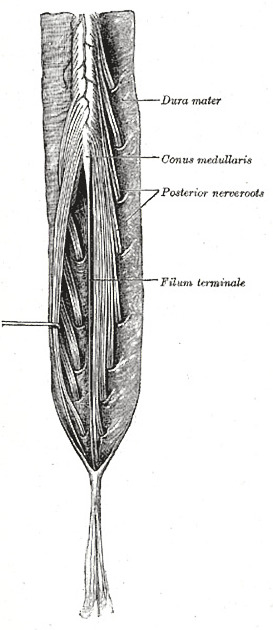Cauda equina
Citation, DOI, disclosures and article data
At the time the article was created Henry Knipe had no recorded disclosures.
View Henry Knipe's current disclosuresAt the time the article was last revised Yvette Mellam had no financial relationships to ineligible companies to disclose.
View Yvette Mellam's current disclosuresThe cauda equina is the collective term given to nerve roots distal to the conus medullaris, which occupy the lumbar cistern.
Its name comes from the Latin for "horse's tail".
The cauda equina is contained within the thecal sac and suspended in cerebrospinal fluid (CSF). The lower sacral (S2-S5) and coccygeal roots are located in the dorsal aspect of the sac, whereas the lumbar and first sacral roots lie obliquely as they descend.
The nerves of the cauda equina supply innervation to pelvic organs, internal and external anal sphincter, perineal sensation, and the lower limbs.
Blood supply comes from the anterior and posterolateral spinal arteries as well as radicular branches from segmental arteries.
Related pathology
Incoming Links
- Arachnoiditis
- Conus medullaris
- Radicular vein
- Lipomatosis
- Spinal cord compression (summary)
- Lumbar cistern
- Spinal pia mater
- Spinal epidermoid cyst
- Lumbar spinal stenosis (grading)
- Conjoined nerve root
- Thoracolumbar injury classification and severity score (TLICS)
- Déjerine-Sottas disease
- Fifth lumbar vertebra (L5)
- Lumbar spine
- Investigating cauda equina syndrome (summary)
- Bladder impairment following spinal cord injury
- Spinal meninges
- Poliomyelitis-like syndrome
- Epidural lipomatosis
- Dorsal dermal sinus
- Caudal regression syndrome
- Pseudosinus tract
- Cauda equina (Gray's illustration)
- Zuckerguss of the spine
- Cauda equina syndrome
- Myxopapillary ependymoma
- Guillain-Barré syndrome
- Tuberculous meningitis with subarachnoid spinal involvement
- Guillain-Barré syndrome
- Tuberculous meningitis: cerebral tuberculomas and spinal cord involvement
- Redundant cauda equina nerve roots in severe spinal canal stenosis
- Neurofibromatosis type 2
- Leptomeningeal drop metastases - medulloblastoma
- L4/5 disc extrusion causing cauda equina syndrome
- Pott disease causing cauda equina syndrome
- Enterovirus 71 infection
- Haemangioblastoma of the thoracic spine
Related articles: Anatomy: Spine
-
osteology
- vertebrae
- spinal canal
- cervical spine
- thoracic spine
- lumbar spine
- sacrum
- coccyx
-
anatomical variants
- vertebral body
- neural arch
- transitional vertebrae
- ossicles
- ossification centres
- intervertebral disc
- articulations
- ligaments
- musculature of the vertebral column
- muscles of the neck
- muscles of the back
-
suboccipital muscle group
- rectus capitis posterior major muscle
- rectus capitis posterior minor muscle
- obliquus capitis superior muscle
- obliquus capitis inferior muscle
- splenius capitis muscle
- splenius cervicis muscle
- erector spinae group
- transversospinalis group
- quadratus lumborum muscle
-
suboccipital muscle group
- spinal meninges and spaces
-
spinal cord
- gross anatomy
-
white matter tracts (white matter)
- corticospinal tract
- anterolateral columns
- lateral columns
-
dorsal columns
- fasiculus gracilis (column of Goll)
- fasiculus cuneatus (column of Burdach)
- grey matter
- nerve root
- central canal
- functional anatomy
- spinal cord blood supply
- sympathetic chain






 Unable to process the form. Check for errors and try again.
Unable to process the form. Check for errors and try again.